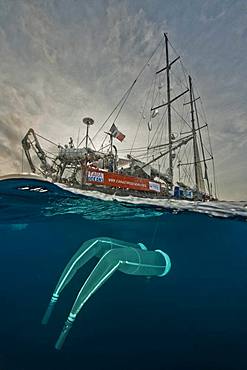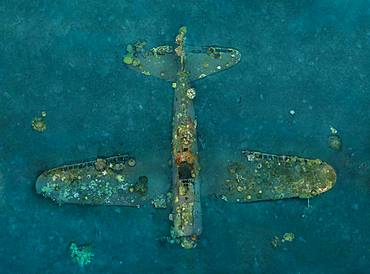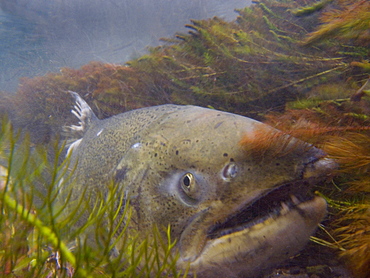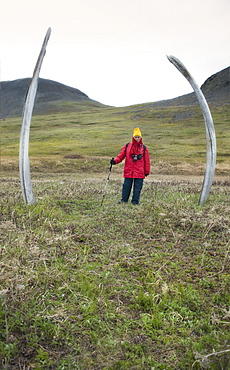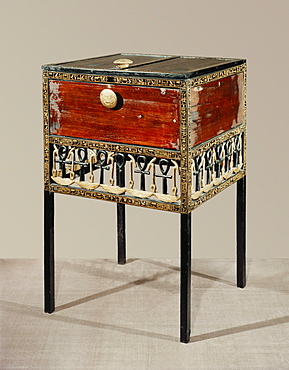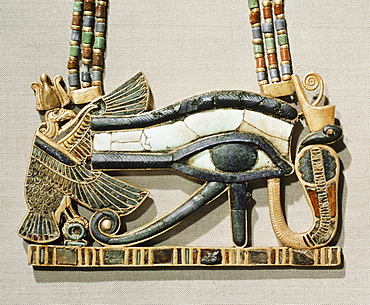Recent searches
Loading...
1350-673 - The Tachinidae are a large and variable family of true flies within the insect order Diptera, with more than 8,200 known species and many more to be discovered. Most are protelean parasitoids, or occasionally parasites, of arthropods.
1349-223 - James Van Allen, American Space Scientist
805-1375 - Rawak Buddhist stupa, 4th century, discovered by Aurel Stein in 1901, Hotan, Xinjiang, China, Asia
860-287442 - Tara Pacific expedition - november 2017 Kimbe Bay, papua New Guinea, Zero wreck: Coral growth on this wreck is from a period of 74 years ! D: 15 m The ZERO, is a Japanese WW2 fighter plane wreck. This Zero wreck was discovered in January 2000 by local William Nuli while he was freediving for sea cucumbers. He asked the Walindi Plantation Resort dive team if they might know what it was, and when they investigated they uncovered the intact wreck of a Zero fighter, resting on a sedimented bottom in 15 m depth. This World War II Japanese fighter is almost completely intact. The plane is believed to have been ditched, the pilot is believed to have survived, but was never found on the island. He never returned home. Maybe he disappeared in the jungle? On 26th December 1943, during the battle of Cape Gloucester, the Japanese pilot made an emergency landing, ditching his Mitsubishi A6M Zero plane into the sea approximately 100m off West New Britain Province. The plane was piloted by PO1 Tomiharu Honda of the 204st K?k?tai. His fate is unknown but it is believed the he made a controlled water landing after running out of fuel and survived. Although he failed to return to his unit, the plane was found with the throttle and trim controls both set for landing and the canopy was open. There are no visible bullet holes or other shrapnel damage and the plane is still virtually intact after over 70 years underwater. It is a A6M2 Model 21 Zero, made famous for its use in Kamikaze attacks by the Japanese Imperial Navy. The wreck has the Manufacture Number 8224 and was built by Nakajima in late August 1942.
860-287450 - Tara Oceans Expeditions - May 2011. Tara with deployed plancton nets. On "station", the boat is drifting without engine or sails. Tara Oceans, a unique expedition: Tara Oceans is the very first attempt to make a global study of marine plankton, a form of sea life that includes organisms as small as viruses and bacterias, and as big as medusas. Our goal is to better understand planktonic ecosystems by exploring the countless species, learning about interactions among them and with their environment. Marine plankton is the only ecosystem that is almost continuous over the surface of the Earth. Studying plankton is like taking the pulse of our planet. Recently, scientists have discovered the great importance of plankton for the climate: populations of plankton are affected very rapidly by variations in climate. But in turn they can influence the climate by modifying the absorption of carbon. In a context of rapid physico-chemical changes, for example the acidification observed today in the world's oceans, it is urgent to understand and predict the evolution of these particular ecosystems. Finally, plankton is an astonishing way of going back in time ? a prime source of fossils. Over the eons, plankton has created several hundred meters of sediment on the ocean floors. This allows us to go back in time, to the first oceans on Earth, and better understand the history of our biosphere. More than 12 fields of research are involved in the project, which will bring together an international team of oceanographers, ecologists, biologists, geneticists, and physicists from prestigious laboratories headed by Eric Karsenti of the European Molecular Biology Laboratory. Galapagos
860-287440 - Tara Pacific expedition - november 2017 Zero wreck, vertical view Orthomosaic from 3D photogrammetry (13500 x 10000 px). D: 15 m Kimbe Bay, papua New Guinea, Coral growth on this wreck is from a period of 74 years ! The ZERO, is a Japanese WW2 fighter plane wreck. This Zero wreck was discovered in January 2000 by local William Nuli while he was freediving for sea cucumbers. He asked the Walindi Plantation Resort dive team if they might know what it was, and when they investigated they uncovered the intact wreck of a Zero fighter, resting on a sedimented bottom in 15 m depth. This World War II Japanese fighter is almost completely intact. The plane is believed to have been ditched, the pilot is believed to have survived, but was never found on the island. He never returned home. Maybe he disappeared in the jungle? On 26th December 1943, during the battle of Cape Gloucester, the Japanese pilot made an emergency landing, ditching his Mitsubishi A6M Zero plane into the sea approximately 100m off West New Britain Province. The plane was piloted by PO1 Tomiharu Honda of the 204st K?k?tai. His fate is unknown but it is believed the he made a controlled water landing after running out of fuel and survived. Although he failed to return to his unit, the plane was found with the throttle and trim controls both set for landing and the canopy was open. There are no visible bullet holes or other shrapnel damage and the plane is still virtually intact after over 70 years underwater. It is a A6M2 Model 21 Zero, made famous for its use in Kamikaze attacks by the Japanese Imperial Navy. The wreck has the Manufacture Number 8224 and was built by Nakajima in late August 1942.
685-2674 - Remains of the Roman amphitheatre discovered in the basement of the Guildhall, London, EC2, England, United Kingdom, Europe
1195-119 - A geological formation known as the Flaming Cliffs where Andrew Shapman expedition discovered the first dinosaurs eggs, Mongolia, Central Asia, Asia
857-91073 - November 7, 2008 Mt Shasta CA A spawned-out Chinook salmon watches over her redd in the Shasta River where it runs through Big Springs Ranch about 2 miles north of the town of Mt Shasta. The ranch, which is contributing to degraded habitat conditions, which actually warm water tempt by upwards of 10 degrees as the river passes through the ranch and then spills into the Klameth, is currently under contract for purchase by TNC, therefor TNC and partner organizations have been allowed to research this stretch of river for the first time. They have discovered that is it a very fertile juvenile rearing area and that there are a surprising number of returning salmon in spite of habitat degraded by grazing cattle (often in the river) and irrigation practices. If this purchase is successful, TNC has the chance to improve a large stretch of habitat and quickly improve conditions that will effect numbers of returning fish and habitat in the Shasta and Klameth Rivers. In California, The Nature Conservancy is focusing its efforts on protecting the Shasta River and its tributaries, which create one of the most important spawning nurseries for Chinook salmon in the entire Klamath Basin, United States of America
857-91077 - November 12, 2008 Mt Shasta CA, Big Springs ranch Carson Jeffres (rt) Staff Research Associate for UC Davis Center for watershed Sciences, and Andrew Nichols, Jr Specialist (UC Davis Center for watershed Sciences,) conducting research in the Shasta River where it runs through Big Springs Ranch about 20 miles north of the town of Mt Shasta. The ranch, which is contributing to degraded habitat conditions that warm water temps by upwards of 10 degrees as the river passes through the ranch and then spills into the Klameth, is currently under contract for purchase by TNC, therefor TNC and partner organizations have been allowed to research this stretch of river for the first time. They have discovered that is it a very fertile juvenile rearing area and that there are a surprising number of returning salmon in spite of habitat degrated by grazing cattle (often in the river) and irrigation practices. If this purchase is sucessful, TNC has the chance to improve a large stretch of habitiat and qucikly improve conditions that will effect numbers of returning fish and habitiat in the Shasta and Klameth Rivers. The Shasta River and its tributaries create one of the most important spawning nurseries for Chinook salmon in the entire Klamath Basin, United States of America
857-91084 - Mt Shasta CA, Big Spring Ranch Bill Chesney from the CA Dept of Fish & Game counting redds in a stretch of river that is heavily grazed by cattle who have full access to the river and often drink and eat in it. Mt Shasta in the background. The Shasta River runs through Big Springs Ranch about 20 miles north of the town of Mt Shasta. The ranch, which is contributing to degraded habitat conditions, and actually warming water temps by upwards of 10 degrees as the river passes through the ranch and then spills into the Klameth, is currently under contract for purchase by TNC. Since the contract began, TNC and partner organizations have been allowed to research this stretch of river for the first time. They have discovered that is it a very fertile juvenile rearing area and that there are a surprising number of returning salmon in spite of habitat degradation by grazing cattle (often in the river) and irrigation practices. If this purchase is successful, TNC has the chance to improve a large stretch of habitat and quickly improve conditions that will effect numbers of returning fish and habitat in the Shasta and Klameth Rivers. The Shasta River and its tributaries create one of the most important spawning nurseries for Chinook salmon in the entire Klamath Basin, United States of America
857-91074 - November 7, 2008 Mt Shasta CA A spawned-out Chinook salmon watches over her redd in the Shasta River where it runs through Big Springs Ranch about 2 miles north of the town of Mt Shasta. The ranch, which is contributing to degraded habitat conditions, which actually warm water tempt by upwards of 10 degrees as the river passes through the ranch and then spills into the Klameth, is currently under contract for purchase by TNC, therefor TNC and partner organizations have been allowed to research this stretch of river for the first time. They have discovered that is it a very fertile juvenile rearing area and that there are a surprising number of returning salmon in spite of habitat degraded by grazing cattle (often in the river) and irrigation practices. If this purchase is successful, TNC has the chance to improve a large stretch of habitat and quickly improve conditions that will effect numbers of returning fish and habitat in the Shasta and Klameth Rivers. In California, The Nature Conservancy is focusing its efforts on protecting the Shasta River and its tributaries, which create one of the most important spawning nurseries for Chinook salmon in the entire Klamath Basin, United States of America
832-295922 - Deformed skulls, discovered in the Tihuanaku temples, Bolivia
1161-1111 - Figurines in the Museum of the Qin Terracotta Warriors, the mausoleum of Qin Shi Huang,emperor of China, Xian, Shaanxi Province, Northwest China discovered in 1974.
1161-472 - Llama, Machu Picchu ruins of the Inca citadel discovered in 1911 in Peru, South America
238-6245 - Fountain discovered by archaeologists in 1923, 11th century Elephant Cave (Goa Gajah), Bali, Indonesia, Southeast Asia, Asia
238-6246 - Fountain discovered by archaeologists in 1923, 11th century Elephant Cave (Goa Gajah), Bali, Indonesia, Southeast Asia, Asia
814-1518 - The only re-discovered cannon of the HMS Bounty, Pitcairn Island, Pacific
832-45401 - Monument to Leif Ericson, also known as Leifur Eiriksson, an explorer who discovered America, Hallgrimskirkja church, church of Hallgrimur, a landmark of Reykjavik, Iceland, Europe
857-6668 - The California Gulch, Leadville, Colorado, where gold was first discovered in 1860. It is now a superfund site.
1196-239 - A solitary mask dancer appears wearing a frightening mask and silk brocade. they circle the courtyard with sprightly leaps. called protectors of faith, or dharmapdla, the origins of figures like these can be traced back to the pre-aryan peoples of india. originally known as yaksas (literally, a wondrous thing), they were tree spirits, who were accepted by the buddhists as defenders of the faith. in nepal and tibet, as in india, local deities were converted into protectors. a devotee of an alien sect devised a means to humiliate the buddha and his disciples. the buddha discovered it and succeeded in converting him to his teaching. due to lack of wisdom, the buddha remarked, some could not realize the goodness of his disciples and he compared the ignorant to the blind and the wise to those who have eyes.nobody is condemned in buddhism, for greatness is latent even in the seemingly lowliest just as lotuses spring from muddy ponds. -the dhammapada. solu khumbu, nepal
1194-1454 - Egypt fresco of the annunciation of the virgin, 9th century, discovered in by the french institute, the virgins church el sourian coptic orthodox monastery, natrun
909-168 - Hope Bay hut. Hope Bay was discovered in 1902 by the Swedish expedition led by Otto Nordenskjöld. He named it Hope Bay, after three of his party inadvertently wintered there during 1903; they were dropped off not long before their ship, Antarctic, sank and the sound beyond the bay bears the name of their doomed vessel. Their makeshift stone hut stands near the dock – it was largely rebuilt over the summer season of 1966-67. Hope Bay, Antarctic Sound, Weddell Sea
921-791 - Whalebone Alley grand vista, female tourist standing on cliff face, Itygran Island (Bering Sea) Russia, Asia. MORE INFO: Whale Bone Alley was discovered by Soviet archaeologists in 1976, but has remained untouched since and little is known of this place. There is a long double line of bowhead whale bones -- jaws and ribs -- running parallel along the shore for hundreds of yards. Many of the bones, especially the enormous jaw bones, are still standing, propped up by lichen-covered rocks. The location is thought to have been used in about 1300 as a ceremonial site, for a men's secret society or feasting site.
921-701 - Whalebone Alley, Bowhead whale bone, Itygran Island (Bering Sea) Russia, Asia. MORE INFO: Whale Bone Alley was discovered by Soviet archaeologists in 1976, but has remained untouched since and little is known of this place. There is a long double line of bowhead whale bones -- jaws and ribs -- running parallel along the shore for hundreds of yards. Many of the bones, especially the enormous jaw bones, are still standing, propped up by lichen-covered rocks. The location is thought to have been used in about 1300 as a ceremonial site, for a men's secret society or feasting site.
921-703 - Whalebone Alley, Bowhead whale bones, Itygran Island (Bering Sea) Russia, Asia. MORE INFO: Whale Bone Alley was discovered by Soviet archaeologists in 1976, but has remained untouched since and little is known of this place. There is a long double line of bowhead whale bones -- jaws and ribs -- running parallel along the shore for hundreds of yards. Many of the bones, especially the enormous jaw bones, are still standing, propped up by lichen-covered rocks. The location is thought to have been used in about 1300 as a ceremonial site, for a men's secret society or feasting site.
921-699 - Whalebone Alley grand vista, female tourist standing on cliff face, Itygran Island (Bering Sea) Russia, Asia. MORE INFO: Whale Bone Alley was discovered by Soviet archaeologists in 1976, but has remained untouched since and little is known of this place. There is a long double line of bowhead whale bones -- jaws and ribs -- running parallel along the shore for hundreds of yards. Many of the bones, especially the enormous jaw bones, are still standing, propped up by lichen-covered rocks. The location is thought to have been used in about 1300 as a ceremonial site, for a men's secret society or feasting site.
921-702 - Whalebone Alley, female tourist sitting on bowhead whale bone, Itygran Island (Bering Sea) Russia, Asia. MORE INFO: Whale Bone Alley was discovered by Soviet archaeologists in 1976, but has remained untouched since and little is known of this place. There is a long double line of bowhead whale bones -- jaws and ribs -- running parallel along the shore for hundreds of yards. Many of the bones, especially the enormous jaw bones, are still standing, propped up by lichen-covered rocks. The location is thought to have been used in about 1300 as a ceremonial site, for a men's secret society or feasting site.
921-700 - Whalebone Alley, female tourist standing around still intact extremly old inuit elder grave, skeleton still present. Itygran Island (Bering Sea) Russia, Asia. MORE INFO: Whale Bone Alley was discovered by Soviet archaeologists in 1976, but has remained untouched since and little is known of this place. There is a long double line of bowhead whale bones -- jaws and ribs -- running parallel along the shore for hundreds of yards. Many of the bones, especially the enormous jaw bones, are still standing, propped up by lichen-covered rocks. The location is thought to have been used in about 1300 as a ceremonial site, for a men's secret society or feasting site.
921-704 - Whalebone Alley, female tourist standing between bow head whale rib bones, Itygran Island (Bering Sea) Russia, Asia. MORE INFO: Whale Bone Alley was discovered by Soviet archaeologists in 1976, but has remained untouched since and little is known of this place. There is a long double line of bowhead whale bones -- jaws and ribs -- running parallel along the shore for hundreds of yards. Many of the bones, especially the enormous jaw bones, are still standing, propped up by lichen-covered rocks. The location is thought to have been used in about 1300 as a ceremonial site, for a men's secret society or feasting site.
921-810 - Whalebone Alley grand vista, high altitude flora, Itygran Island (Bering Sea) Russia, Asia. MORE INFO: Whale Bone Alley was discovered by Soviet archaeologists in 1976, but has remained untouched since and little is known of this place. There is a long double line of bowhead whale bones -- jaws and ribs -- running parallel along the shore for hundreds of yards. Many of the bones, especially the enormous jaw bones, are still standing, propped up by lichen-covered rocks. The location is thought to have been used in about 1300 as a ceremonial site, for a men's secret society or feasting site.
979-1412 - Emperor penguin (Aptenodytes forsteri) from a recently discovered colony on Snowy Hill in the Weddell Sea. This may be the northernmost Emperor penguin colony in Antarctica.
979-1414 - Juvenile Emperor penguin (Aptenodytes forsteri) from a recently discovered colony on Snowy Hill in the Weddell Sea. This may be the northernmost Emperor penguin colony in Antarctica.
979-1411 - Juvenile Emperor penguin (Aptenodytes forsteri) from a recently discovered colony on Snowy Hill in the Weddell Sea. This may be the northernmost Emperor penguin colony in Antarctica.
979-1413 - Juvenile Emperor penguin (Aptenodytes forsteri) from a recently discovered colony on Snowy Hill in the Weddell Sea. This may be the northernmost Emperor penguin colony in Antarctica.
979-1410 - Emperor penguins (Aptenodytes forsteri) hauled out on fresh ice from a recently discovered colony on Snowy Hill in the Weddell Sea. This may be the northernmost Emperor penguin colony in Antarctica.
834-5214 - Plaque commemorating Sir Alexander Fleming, discovered of penicillin, London, England, United Kingdom, Europe
829-94 - Mausoleum and Saadian tombs in Marrakech Morocco where over 60 members of the Saadi dynasty are buried. The dynasty ruled from the mid 16th to mid 17th century. The tombs were sealed and only re-discovered in 1917
829-93 - Mausoleum and Saadian tombs in Marrakech Morocco where over 60 members of the Saadi dynasty are buried. The dynasty ruled from the mid 16th to mid 17th century. The tombs were sealed and only re-discovered in 1917
829-92 - Mausoleum and Saadian tombs in Marrakech Morocco where over 60 members of the Saadi dynasty are buried. The dynasty ruled from the mid 16th to mid 17th century. The tombs were sealed and only re-discovered in 1917
823-488 - Skull of Mountain Gorilla (Gorilla gorilla beringei), holotype 1902, Museum fur Natuurkunde, Berlin, discovered by Captain Robert von Beringe, Virunga Volcanoes, Rwanda, Africa
823-487 - Skull of Mountain Gorilla (Gorilla gorilla beringei), holotype 1902, Museum fur Natuurkunde, Berlin, discovered by Captain Robert von Beringe, Virunga Volcanoes, Rwanda, Africa
788-15259 - Coin-operated binoculars at the seaside, Baie de Biarritz, Biarritz, Pyrenees-Atlantiques, France
788-15296 - Rear view of a man with a hand-held telescope, Via Partenope, Bay of Naples, Naples, Naples Province, Campania, Italy
797-5211 - Kuelap Fortress ruins Chachapoyas culture also known as the Cloud Forest People, Site discovered 1843, Steep narrow pathway between stone walls, Chachapoyas, Amazonas, Peru
557-2155 - Archaeological site of Qumran where Dead Sea scrolls discovered in caves in cliffs, Judean Desert, Israel, Middle East
788-14817 - High angle view of Nazca lines, Nazca, Peru
788-14557 - High angle view of Nazca lines, Nazca, Peru
788-14544 - High angle view of Nazca lines, Nazca, Peru
788-14535 - High angle view of Nazca lines, Nazca, Peru
788-14523 - High angle view of Nazca lines making a shape of candlestick holder, Paracas Peninsula, Paracas National Reserve, Paracas, Ica Region, Peru
788-14508 - High angle view of Nazca lines, Nazca, Peru
788-14504 - High angle view of Nazca lines, Nazca, Peru
788-13375 - Rear view of two scuba divers walking on the beach, Honduras
744-94 - Detail of the second mummiform coffin made from gold-plated wood inlaid with glass-paste, from the tomb of the pharaoh Tutankhamun, discovered in the Valley of the Kings, Thebes, Egypt, North Africa, Africa
788-5677 - Low section view of a man and a woman looking at a map
700-11592 - Syria, Damascus, The Omayyad Mosque By Khalif Walid The First And 12 000 Workers, The Site Was Occupied By A Temple Then A Church, Pilgrims From The Whole Islamic World Visit The Mausoleum Supposed To Contain The Prophet Yaya's Head (Alias St John The Baptist) Discovered In Viii Th Cent, Iranian Shiites Believe The Prophet Mahomet's Grandson Hussein's Head (Son Of Ali) Was Also Stored Here, Copper Spacelab In The Yard
744-11 - A board game of senet, in ebony and ivory, from the tomb of the pharaoh Tutankhamun, discovered in the Valley of the Kings, Thebes, Egypt, North Africa, Africa
744-1 - The second mummiform coffin made from gold-plated wood inlaid with glass-paste, from the tomb of the pharaoah Tutankhamun, discovered in the Valley of the Kings, Thebes, Egypt, North Africa, Africa
744-10 - Coffer from the treasury, made from wood and ivory with applied gold and silver, from the tomb of the pharaoh Tutankhamun, discovered in the Valley of the Kings, Thebes, Egypt, North Africa, Africa
744-12 - Cedarwood and gilded ebony cabinet decorated with hieroglyphic symbols ensuring divine life, from the tomb of the pharaoh Tutankhamun, discovered in the Valley of the Kings, Thebes, Egypt, North Africa, Africa
744-13 - Detail of queen Ankhesenamun on the gilded shrine, from the tomb of the pharoah Tutankhamun, discovered in the Valley of the Kings, Thebes, Egypt, North Africa, Africa
744-14 - Gilt wood statuette of Tutankhamun on a boat with a harpoon, from the tomb of the pharaoh Tutankhamun, discovered in the Valley of the Kings, Thebes, Egypt, North Africa, Africa
744-15 - Gilt wood statuette of Tutankhamun on a boat with a harpoon, from the tomb of the pharaoh Tutankhamun, discovered in the Valley of the Kings, Thebes, Egypt, North Africa, Africa
744-16 - Gilt wood statuette of the king, from the tomb of the pharaoh Tutankhamun, discovered in the Valley of the Kings, Thebes, Egypt, North Africa, Africa
744-17 - Lid of an alabaster jar decorated with a bird in a nest and eggs in a bowl, from the tomb of the pharaoh Tutankhamun, discovered in the Valley of the Kings, Thebes, Egypt, North Africa, Africa
744-18 - Gilded and stuccoed wooden head of the sacred cow, from the tomb of the pharaoh Tutankhamun, discovered in the Valley of the Kings, Thebes, Egypt, North Africa, Africa
744-19 - Dummy head of the young king, made from stuccoed and painted wood, from the tomb of the pharaoh Tutankhamun, discovered in the Valley of the Kings, Thebes, Egypt, North Africa, Africa
744-2 - Detail of the second mummiform coffin made from gold-plated wood inlaid with glass-paste, from the tomb of the pharaoh Tutankhamun, discovered in the Valley of the Kings, Thebes, Egypt, North Africa, Africa
744-20 - Painted alabaster unguent jar showing hunting scene, with the king as a lion, from the tomb of the pharaoh Tutankhamun, discovered in the Valley of the Kings, Thebes, Egypt, North Africa, Africa
744-21 - Detail of a painted alabaster unguent jar, from the tomb of the pharaoh Tutankhamun, discovered in the Valley of the Kings, Thebes, Egypt, North Africa, Africa
744-22 - Inlaid alabaster unguent jar in the form of an ibex, with one natural horn, from the tomb of the pharaoh Tutankhamun, discovered in the Valley of the Kings, Thebes, Egypt, North Africa, Africa
744-23 - Inlaid alabaster unguent jar in the form of an ibex, with one natural horn, from the tomb of the pharaoh Tutankhamun, discovered in the Valley of the Kings, Thebes, Egypt, North Africa, Africa
744-24 - Alabaster vase inlaid with floral garlands, from the tomb of the pharaoh Tutankhamun, discovered in the Valley of the Kings, Thebes, Egypt, North Africa, Africa
744-25 - Mirror case in the form of an ankh, the sign of life, made of gilt wood inlaid with glass-paste, from the tomb of the pharaoh Tutankhamun, discovered in the Valley of the Kings, Thebes, Egypt, North Africa, Africa
744-26 - Opaque blue glass-paste funerary headrest with gold frieze, from the tomb of the pharaoh Tutankhamun, discovered in the Valley of the Kings, Thebes, Egypt, North Africa, Africa
744-27 - Folding headrest in painted ivory decorated with the head of the protective spirit Bes, from the tomb of the pharaoh Tutankhamun, discovered in the Valley of the Kings, Thebes, Egypt, North Africa, Africa
744-28 - Dummy head of the young king, made from stuccoed and painted wood, from the tomb of the pharaoh Tutankhamun, discovered in the Valley of the Kings, Thebes, Egypt, North Africa, Africa
744-29 - Pectoral decorated with the vulture of Upper Egypt, made of gold cloisonne inlaid with glass paste, from the tomb of the pharaoh Tutankhamun, discovered in the Valley of the Kings, Thebes, Egypt, North Africa, Africa
744-3 - Image of the king's mummy on its funeral bed flanked by the king's two souls, dedicated by Maya, from the tomb of the pharoah Tutankhamun, discovered in the Valley of the Kings, Thebes, Egypt, North Africa, Africa
744-30 - Pendant in the form of a boat showing a scarab, the symbol of the god's resurrection, flanked by two royal serpents, from the tomb of the pharaoh Tutankhamun, discovered in the Valley of the Kings, Thebes, Egypt, North Africa, Africa
744-31 - Necklace with pendant in the form of a boat showing a scarab, the symbol of the god's resurrection, flanked by two royal serpents, from the tomb of the pharaoh Tutankhamun, discovered in the Valley of the Kings, Thebes, Egypt, North Africa, Africa
744-32 - Pectoral of the sacred eye flanked by the serpent goddess of the North and the vulture goddess of the South, made from gold cloisonne with glass-paste, from the tomb of the pharaoh Tutankhamun, discovered in the Valley of the Kings, Thebes, Egypt, North Africa, Africa
744-33 - Pectoral decorated with winged scarab, protected by the goddesses Isis and Nephthys, made from gold cloisonne with glass-paste, from the tomb of the pharaoh Tutankhamun, discovered in the Valley of the Kings, Thebes, Egypt, North Africa, Africa
744-34 - One of the four small gold mummiform coffins placed in the canopic urns, from the tomb of the pharaoh Tutankhamun, discovered in the Valley of the Kings, Thebes, Egypt, North Africa, Africa
744-35 - One of the four small gold mummiform coffins placed in the canopic urns, from the tomb of the pharaoh Tutankhamun, discovered in the Valley of the Kings, Thebes, Egypt, North Africa, Africa
744-36 - Ushabti of Tutankhamun, showning king wearing the red crown of the North, from the tomb of the pharaoh Tutankhamun, discovered in the Valley of the Kings, Thebes, Egypt, North Africa, Africa

















